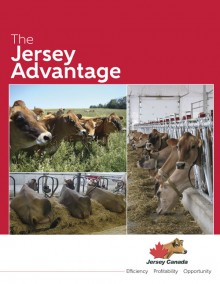A milking Jersey cow produces 55% less phosphorus (P2O5) in her manure than other dairy breeds. This fact is recognized by the Government of Quebec, as outlined in the Agricultural Operations Regulation Environment Quality Act (Chapter Q-2, r.26), and represents an incredible opportunity for dairy producers everywhere to efficiently administering their nutrient management program while maximizing their herd size.Farmers all across the country work diligently to maintain effective nutrient management programs. For dairy producers, this includes applying manure to cropland to ensure a continuous nutrient cycle: nutrients are transported from the field to the barn as feed, and then replaced in the field as manure.
The three key nutrients in plant production are nitrogen, phosphorus, and potassium. Phosphorus is an essential element for profitable plant and animal production. Soil which contains adequate phosphorus will have improved crop quality, increased root growth, earlier crop maturity, and higher grain production. Generally though, manure application is based on meeting a crop’s nitrogen requirements, which tends to result in excess phosphorus and potassium being applied to the soil because of a mismatch between the nutrient content in manure, and the crop’s nutrient needs.
Agricultural runoff is a known contributor of excess phosphorus making its way into surface waters and causing an increase in algae growth, called eutrophication. Built-up phosphorus in the top 5cm of soil is washed into surface waterways, or is carried by water percolating through the soil into ground water. Eutrophication limits light penetration in the water system, depletes dissolved organic carbon, and raises pH levels during the day. Eventually, the dense algal blooms die and decompose, depleting the water’s dissolved oxygen. Conversion tillage, crop residue management, buffer strips, riparian zones, contour tillage, cover crops and settling basins are all methods producers can use to reduce agricultural runoff and increase the soil’s resistance to erosion.
Another important nutrient management technique is called source management. This is where producers minimize the buildup of phosphorus in the soil while optimizing crop growth levels. This involves adjusting the feed program on the farm to meet the cows’ dietary requirements for phosphorus while minimizing phosphorus output in manure. The nutrient content of manure from dairy cattle is affected by a number of factors, including diet, housing and bedding system, method of manure storage, and type of manure application system.
The Jersey’s comparatively small body size combined with higher milk production per unit of body weight results in about 55% less phosphorus per kilogram of manure, compared to other dairy breeds.
In Quebec, the Environment Quality Act requires that solid manure piles near farm buildings must not contain more than 1,600 kg of phosphorus per year (Section 9.3, Environment Quality Act). The Quebec Ministère du Développement durable, Environnement et Lutte contre les changements climatiques recognizes the Jersey’s reduced phosphorus output compared to other breeds of dairy cattle. As a result, consider an example of herd sizes for various breeds to meet the 1,600 kg phosphorus limit:
Quebec Environment Quality Act - Annual Phosphorus (P2O5) Production
| Category | (P2O5) / animal space (kg)2* | % of Herd | Total # Head | Total P2O5 Production(kg) |
| Dairy cow (AY, BS, GU, HO, MS) and its 11-day calf | 51.8 | 52% | 22 | 1129 |
| Dairy heifer (AY, BS, GU, HO, MS) >15 months until 1st lactation | 32.3 | 25% | 10 | 339 |
| Dairy calf (AY, BS, GU, HO, MS) from 12 days-15 months | 13.7 | 23% | 10 | 132 |
| Total | | | 42 | 1600 |
| Jersey cow and its 11-day calf | 23.4 | 52% | 48 | 1129 |
| Jersey heifer >15 months until 1st lactation | 14.6 | 25% | 23 | 339 |
| Jersey calf from 12 days-15 months | 6.2 | 23% | 21 | 132 |
| Total | | | 93 | 1600 |
| Canadienne cow and its 11-day calf | 47.1 | 52% | 24 | 1129 |
| Canadienne heifer >15 months until 1st lactation | 29.4 | 25% | 12 | 339 |
| Canadienne calf from 12 days-15 months | 12.5 | 23% | 11 | 132 |
| Total | | | 46 | 1600 |
Source: Schedule VII; Agricultural Operations Regulation, Environment Quality Act (Ch Q-2, a. 31, 53.30, 70, 109.1 and 124.1)
The accepted average Annual Phosphorus (P2O5) Production for dairy breeds other than Jersey and Canadienne allow for a maximum total herd size of 42 head (including 22 milking & dry females) to meet the 1,600 kg phosphorus annual limit. At the same time, a total herd of 93 Jerseys (including 48 milking & dry females) would still meet the 1,600 kg limit. This suggests that a much larger Jersey herd can operate and adhere to Quebec’s Environment Quality Act without the added expense of constructing and maintaining a manure storage facility. Phosphorus output is just one of many ways that Canadian Jerseys use their body size and high-component milk production to demonstrate their efficiency, profitability, and opportunity! Learn More


